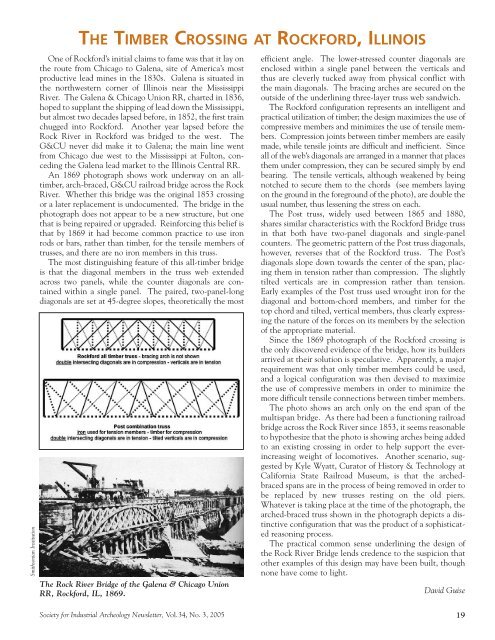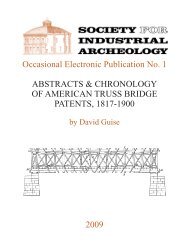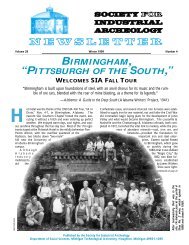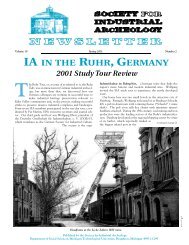SIAN - Society for Industrial Archeology
SIAN - Society for Industrial Archeology
SIAN - Society for Industrial Archeology
You also want an ePaper? Increase the reach of your titles
YUMPU automatically turns print PDFs into web optimized ePapers that Google loves.
Smithsonian Institution<br />
THE TIMBER CROSSING AT ROCKFORD, ILLINOIS<br />
One of Rock<strong>for</strong>d’s initial claims to fame was that it lay on<br />
the route from Chicago to Galena, site of America’s most<br />
productive lead mines in the 1830s. Galena is situated in<br />
the northwestern corner of Illinois near the Mississippi<br />
River. The Galena & Chicago Union RR, charted in 1836,<br />
hoped to supplant the shipping of lead down the Mississippi,<br />
but almost two decades lapsed be<strong>for</strong>e, in 1852, the first train<br />
chugged into Rock<strong>for</strong>d. Another year lapsed be<strong>for</strong>e the<br />
Rock River in Rock<strong>for</strong>d was bridged to the west. The<br />
G&CU never did make it to Galena; the main line went<br />
from Chicago due west to the Mississippi at Fulton, conceding<br />
the Galena lead market to the Illinois Central RR.<br />
An 1869 photograph shows work underway on an alltimber,<br />
arch-braced, G&CU railroad bridge across the Rock<br />
River. Whether this bridge was the original 1853 crossing<br />
or a later replacement is undocumented. The bridge in the<br />
photograph does not appear to be a new structure, but one<br />
that is being repaired or upgraded. Rein<strong>for</strong>cing this belief is<br />
that by 1869 it had become common practice to use iron<br />
rods or bars, rather than timber, <strong>for</strong> the tensile members of<br />
trusses, and there are no iron members in this truss.<br />
The most distinguishing feature of this all-timber bridge<br />
is that the diagonal members in the truss web extended<br />
across two panels, while the counter diagonals are contained<br />
within a single panel. The paired, two-panel-long<br />
diagonals are set at 45-degree slopes, theoretically the most<br />
The Rock River Bridge of the Galena & Chicago Union<br />
RR, Rock<strong>for</strong>d, IL, 1869.<br />
<strong>Society</strong> <strong>for</strong> <strong>Industrial</strong> <strong>Archeology</strong> Newsletter, Vol.34, No. 3, 2005<br />
efficient angle. The lower-stressed counter diagonals are<br />
enclosed within a single panel between the verticals and<br />
thus are cleverly tucked away from physical conflict with<br />
the main diagonals. The bracing arches are secured on the<br />
outside of the underlining three-layer truss web sandwich.<br />
The Rock<strong>for</strong>d configuration represents an intelligent and<br />
practical utilization of timber; the design maximizes the use of<br />
compressive members and minimizes the use of tensile members.<br />
Compression joints between timber members are easily<br />
made, while tensile joints are difficult and inefficient. Since<br />
all of the web’s diagonals are arranged in a manner that places<br />
them under compression, they can be secured simply by end<br />
bearing. The tensile verticals, although weakened by being<br />
notched to secure them to the chords (see members laying<br />
on the ground in the <strong>for</strong>eground of the photo), are double the<br />
usual number, thus lessening the stress on each.<br />
The Post truss, widely used between 1865 and 1880,<br />
shares similar characteristics with the Rock<strong>for</strong>d Bridge truss<br />
in that both have two-panel diagonals and single-panel<br />
counters. The geometric pattern of the Post truss diagonals,<br />
however, reverses that of the Rock<strong>for</strong>d truss. The Post’s<br />
diagonals slope down towards the center of the span, placing<br />
them in tension rather than compression. The slightly<br />
tilted verticals are in compression rather than tension.<br />
Early examples of the Post truss used wrought iron <strong>for</strong> the<br />
diagonal and bottom-chord members, and timber <strong>for</strong> the<br />
top chord and tilted, vertical members, thus clearly expressing<br />
the nature of the <strong>for</strong>ces on its members by the selection<br />
of the appropriate material.<br />
Since the 1869 photograph of the Rock<strong>for</strong>d crossing is<br />
the only discovered evidence of the bridge, how its builders<br />
arrived at their solution is speculative. Apparently, a major<br />
requirement was that only timber members could be used,<br />
and a logical configuration was then devised to maximize<br />
the use of compressive members in order to minimize the<br />
more difficult tensile connections between timber members.<br />
The photo shows an arch only on the end span of the<br />
multispan bridge. As there had been a functioning railroad<br />
bridge across the Rock River since 1853, it seems reasonable<br />
to hypothesize that the photo is showing arches being added<br />
to an existing crossing in order to help support the everincreasing<br />
weight of locomotives. Another scenario, suggested<br />
by Kyle Wyatt, Curator of History & Technology at<br />
Cali<strong>for</strong>nia State Railroad Museum, is that the archedbraced<br />
spans are in the process of being removed in order to<br />
be replaced by new trusses resting on the old piers.<br />
Whatever is taking place at the time of the photograph, the<br />
arched-braced truss shown in the photograph depicts a distinctive<br />
configuration that was the product of a sophisticated<br />
reasoning process.<br />
The practical common sense underlining the design of<br />
the Rock River Bridge lends credence to the suspicion that<br />
other examples of this design may have been built, though<br />
none have come to light.<br />
David Guise<br />
19






